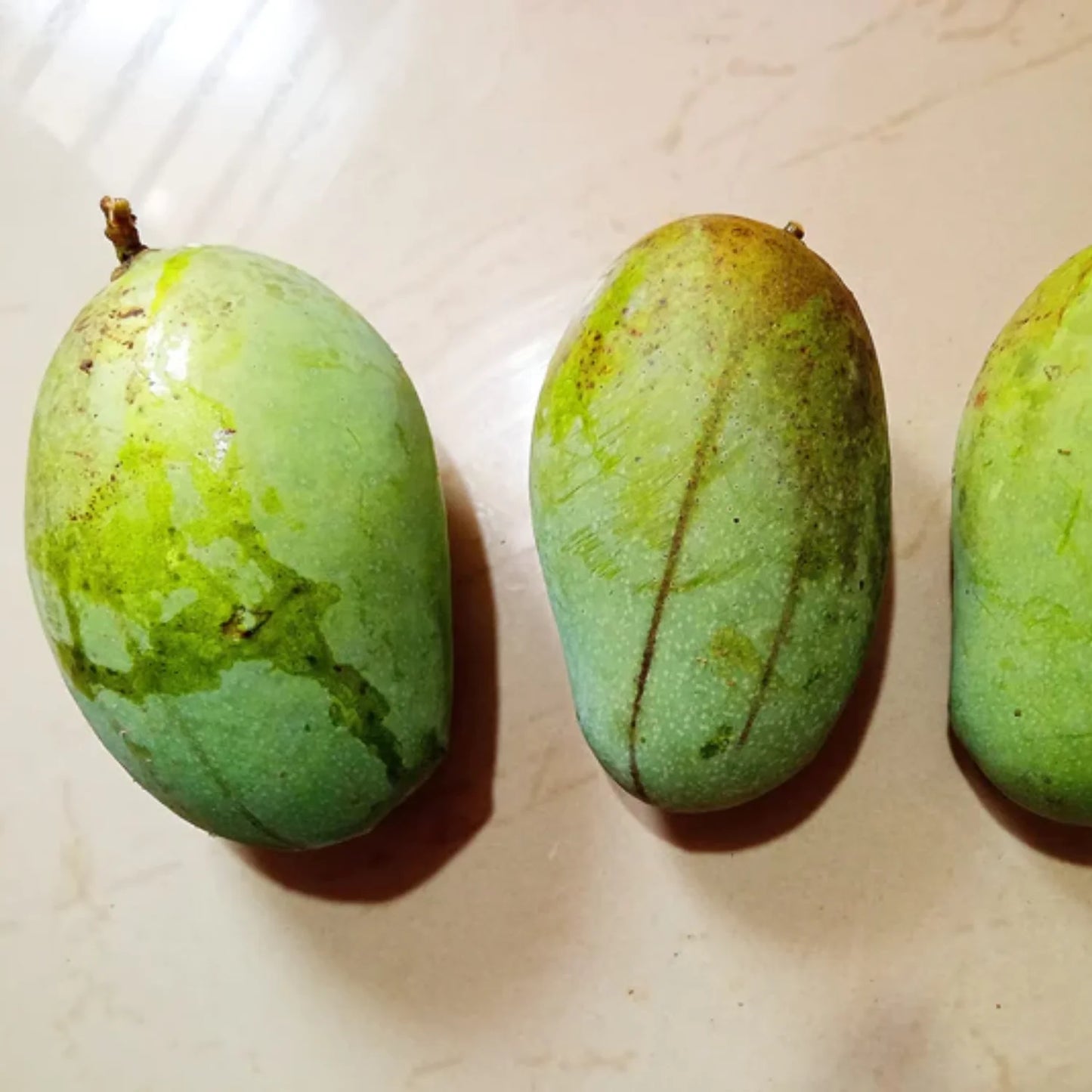Love it? Add to your wishlist
Your favorites, all in one place. Shop quickly and easily with the wishlist feature!
[message]
[title]
[message]

Veliyath Gardens
Couldn't load pickup availability
Kolomb Mango: A Timeless Jewel of Tradition, Taste, and Health
The Kolomb Mango, a cherished tropical fruit, stands as a symbol of tradition and excellence in mango cultivation. With its origins deeply rooted in South Asia, this mango variety continues to captivate fruit lovers with its distinctive flavor, health benefits, and cultural significance. The Kolomb Mango tree is a majestic evergreen, offering not just an abundance of luscious fruits but also an ecological balance to its surroundings. Cultivating this remarkable mango tree in your garden ensures a connection to both nature and heritage, making it a prized addition to any landscape.
Common Names: Kolomb Mango, King Mango, Traditional Mango
Botanical Name: Mangifera indica
Regional Names:
India: Kolomb Aam
Bangladesh: Kolomb Am
Myanmar: Mwe-Hnin
Kolomb Mango traces its roots to the fertile lands spanning northwestern Myanmar, Bangladesh, and India. As one of the most revered mango varieties, it has played a significant role in traditional agriculture and local folklore for centuries. In many cultures, the mango tree is regarded as a sacred symbol of prosperity and fertility. The fruit is exchanged as a token of goodwill and is a centerpiece in religious festivals and ceremonies. Mango leaves are commonly used in Indian homes during auspicious occasions, signifying abundance and well-being.
The Kolomb Mango tree is an evergreen with a spreading, umbrella-shaped canopy that provides ample shade.
Tree Appearance: Large, with dark green, glossy leaves and a dense foliage cover.
Growth Rate: Moderate to fast-growing, depending on climatic conditions.
Blooming and Fruiting: Produces fragrant flowers in clusters, followed by fruiting within 2–3 years under optimal conditions.
Soil and Climate:
Prefers well-drained, loamy soil with a slightly acidic to neutral pH.
Thrives in tropical and subtropical regions with warm temperatures and full sunlight.
Kolomb Mango is renowned for its size variations, ranging from small to exceptionally large fruits.
Size and Weight: Ranges between 50 grams to 1.5 kilograms.
Color: Matures into shades of green, yellow, orange, or deep red, depending on ripeness.
Texture: Smooth, fiberless to slightly fibrous flesh that melts in the mouth.
Taste:
Raw: A tangy and sour punch, making it perfect for pickles and condiments.
Ripe: Sweet, buttery, and aromatic with tropical floral notes.
Aroma: Rich and captivating, a blend of fruity and floral undertones.
Kolomb Mango is often hailed as a "superfruit" due to its impressive nutritional composition.
Per 100 grams:
Calories: ~60 kcal
Vitamin A: Supports vision and skin health.
Vitamin C: Strengthens immunity and promotes collagen synthesis.
Dietary Fiber: Aids digestion and regulates blood sugar levels.
Antioxidants: Beta-carotene, flavonoids, and polyphenols combat oxidative stress.
Minerals: Contains potassium, magnesium, and trace elements like zinc and copper.
Boosts Immunity: The high Vitamin C content fortifies the immune system.
Enhances Digestion: Natural enzymes aid in nutrient absorption and gut health.
Promotes Heart Health: Potassium helps regulate blood pressure and cardiovascular functions.
Improves Skin and Hair: Antioxidants combat aging, keeping skin radiant and hair strong.
Weight Management: Low-calorie yet nutrient-rich, making it a great dietary inclusion.
Fights Anemia: Iron-rich content supports hemoglobin production.
Kolomb Mango’s versatility in the culinary world makes it a favorite among chefs and home cooks alike.
Raw Mango Uses:
Pickles and chutneys with a spicy and tangy kick.
Amchur (mango powder) for enhancing traditional spice blends.
Sliced raw mango in summer salads for a refreshing twist.
Ripe Mango Delights:
Enjoyed fresh or blended into juices, lassis, and smoothies.
Used in desserts such as ice creams, puddings, and traditional sweets.
Mixed into tropical salsas and fruit bowls.
Dried Mango:
Dehydrated slices serve as a nutritious snack.
Incorporated into energy bars and granola mixes.
Kolomb Mango trees require care and maintenance to yield high-quality fruits.
Planting and Growth:
Choose a location with direct sunlight for optimal fruit production.
Ensure well-drained soil and avoid waterlogging.
Organic fertilizers enhance tree growth and fruit quality.
Watering:
Young plants need regular watering; mature trees are drought-tolerant.
Pruning:
Periodic pruning encourages air circulation and removes diseased branches.
Pest Control:
Neem oil and organic pesticides prevent infestations.
Pollination:
Bees and butterflies help improve fruit yield.
Kolomb Mango, being a seasonal fruit, can be preserved using various techniques:
Fresh Storage:
Store at room temperature for natural ripening.
Refrigerate ripe mangoes to extend their shelf life.
Freezing:
Mango pulp can be frozen in airtight containers for future use.
Drying:
Sun-drying or dehydrating mango slices creates a long-lasting snack.
Pickling:
Raw mangoes can be preserved with spices and oil for year-round enjoyment.
The Kolomb Mango tree contributes significantly to the environment and economy.
Environmental Contributions:
Absorbs CO₂, improving air quality.
Provides a habitat for pollinators and birds.
Enriches soil health through organic matter decomposition.
Economic Benefits:
High-yielding trees provide a sustainable income source.
Mango-based products like pickles, pulp, and dried slices hold great market value.
Health Booster: A powerhouse of nutrients supporting overall well-being.
Culinary Star: Adds exquisite flavors to an array of dishes.
Garden Aesthetic: Provides shade, greenery, and natural beauty.
Cultural Connection: A symbol of prosperity and tradition.
Sustainable Investment: Offers long-term yields and economic benefits.
The Kolomb Mango is more than just a fruit; it is a legacy of taste, health, and culture. Cultivating this tree not only enriches your garden but also brings an unparalleled experience of tropical delight. With its incredible benefits and exquisite flavors, the Kolomb Mango stands as an irreplaceable addition to any fruit lover’s collection. Veliyath Gardens brings you this exceptional mango variety, ensuring you enjoy its timeless charm for generations to come.
Kolomb Mango trees require care and maintenance to yield high-quality fruits.
Planting and Growth:
Choose a location with direct sunlight for optimal fruit production.
Ensure well-drained soil and avoid waterlogging.
Boosts Immunity: The high Vitamin C content fortifies the immune system.
Enhances Digestion: Natural enzymes aid in nutrient absorption and gut health.
Promotes Heart Health: Potassium helps regulate blood pressure and cardiovascular functions.
The Kolomb Mango is more than just a fruit; it is a legacy of taste, health, and culture. Cultivating this tree not only enriches your garden but also brings an unparalleled experience of tropical delight. With its incredible benefits and exquisite flavors, the Kolomb Mango stands as an irreplaceable addition to any fruit lover’s collection.


